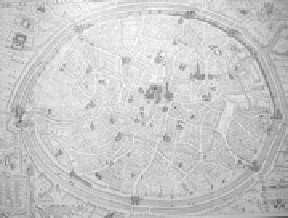Travel Reference
In-Depth Information
hand of Jan van Eyck, the great Flemish Primitive painter (1433).
Jan's wife, Margareta, is there, too. In the 1400s, Bruges rivaled
Florence and Venice as Europe's cultural capital. See the town in
the distance, out Van Eyck's window.
8. Skip it.
9. City fathers grab a ceremonial trowel from a pillow to lay
the fancy cornerstone of the City Hall (1376). Bruges' familiar
towers stand in the background.
10. Skip it.
11. It's a typical market day at the Halls (the courtyard behind
the bell tower). Arabs mingle with Germans in fur-lined coats
and beards in a market where they sell everything from armor to
lemons.
12. A bishop blesses a new canal (1404) as ships sail right by
the city. This was Bruges in its heyday, before the silting of the
harbor. At the far right, the two bearded men with moustaches are
the brothers who painted these murals.
In the adjoining room, old paintings and maps show how little
the city has changed through the centuries. A map (on the right
wall) shows in exquisite detail the
city as it looked in 1562. (The map
is oriented with south on top.)
Find the bell tower, the Church
of Our Lady, and Burg Square,
which back then was bounded on
the north by a cathedral. Notice
the canal (on the west) lead-
ing from the North Sea right to
Market Square. A moat encircled
the city with its gates, unfinished wall, and 28 windmills (four of
which survive today). The mills pumped water to the town's foun-
tains, made paper, ground grain, and functioned as the motor of
the Middle Ages. Most locals own a copy of this map that shows
how their neighborhood looked 400 years ago.
• Back on the square, leaving the City Hall, turn right and go to the
corner.
renaissance Hall
(brugse Vrije)
This elaborately decorated room has
a grand Renaissance chimney carved
from oak by Bruges' Renaissance
man, Lancelot Blondeel, in 1531. If
you're into heraldry, the symbolism
makes this room worth a five-minute
stop. If you're not, you'll wonder




















